By Dave McCracken General Manager





There were 11 of us involved with this particular Week-long Dredging Project. Our team included Craig Colt, Jason and Andrew Inks as individual dredge supervisors, and Otto Gaither as the Project’s shore boss. Over time, we have found that our dredging projects go a lot better when we have an experienced operator supervising each dredge, along with a shore boss that looks after all of the ongoing support needs on the river and in the camp. This leaves me free to work with beginners, coordinate the sampling program, and then push production forward as soon as we locate some high-grade gold.
Craig Colt and I had invested some time the week before, working out where we would launch this Project. New strikes are being made by active members of The New 49’ers all the time along the Club’s extensive mining properties. We pay very close attention to this; because once someone establishes the existence of high-grade in a section of river, it opens up a whole new perspective on where we are likely to discover more high-grade within the immediate area.
We have worked out a sampling program in these Projects that always works. So, how much gold we are going to recover basically comes back to how good the area is where we decide to launch the project in the first place. There is always some risk, though. This is because we never really know how much gold is present until the work is done.
There is not enough time in a week to change our minds and start all over again in a whole new area. So we must choose our area with care. In choosing an area, Craig and I must balance the desire for uncovering rich high-grade gold, with the risk of maybe not finding any high-grade at all. Finding nothing is the nightmare that we have managed to avoid on every project so far. We want to keep it that way!
After weighing all the options, Craig and I decided we were going to launch this Project into the lower-end of K-14. This is an area on the Klamath River just upstream from Portuguese Creek. That is about 20 miles upriver from Happy Camp. There were 2 very serious high-grade discoveries in there a few years ago. Several members were recovering ounces and ounces of nuggets along a bedrock shelf on the edge of the Highway-96 side of the river. They were using 5-inch dredges, although the work could have easily been done with 3-inch dredges, because the water and material were very shallow. Several other members were dredging a rich fine and flake-gold pay-streak using an 8-inch dredge from the far side of the river. But we never saw anyone work the river in the middle, between the two pay-streaks. Craig and I swam that section of the river with mask & snorkel, doing a thorough survey of the bottom. It looked good!
We work hard to prepare in advance for each of these Group Mining Projects. To get a head start, we launched the 8-inch dredge well in advance. This is the piece of equipment which takes the most time to set up. Our dredge supervisors and shore boss went through all our gear several days in advance. We bought all the supplies and fuel necessary to get us through the week. Everything was ready to go!
Then, the day before we were to begin, an oil tanker truck was involved in an accident about 25 miles upstream of our intended project site, and spilled some unknown amount of chemical substance into the river. This prompted the local authorities to issue a heath advisory, telling swimmers and rafters that they should avoid going into the river downstream of the spill.
So there went another perfectly good (great) mining plan! Although we will probably resurrect it during his next season, if nobody else beats us into that location.
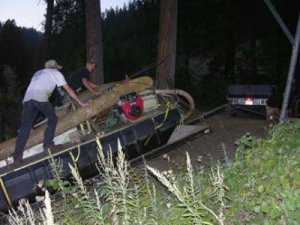 All of this created somewhat of an emergency situation where our dredge supervisors and I found ourselves down on the river after dark on the night before the project, using two winches to pull our 8-inch dredge out of the river, up the side of a rather steep embankment, and onto the road. We needed to do this to keep from losing the first full day of the project!
All of this created somewhat of an emergency situation where our dredge supervisors and I found ourselves down on the river after dark on the night before the project, using two winches to pull our 8-inch dredge out of the river, up the side of a rather steep embankment, and onto the road. We needed to do this to keep from losing the first full day of the project!
Saturday morning found us back in Happy Camp, doing orientation and planning with all of our team partners in this Project. Everybody adjusted quickly to the news that we were going to go back up to UK-3. We coordinated a plan to get all the gear and camping outfits moved up to the Club’s camping location near the UK-Claims. Most of us drove up there in a long parade of trailered dredges and RV’s. That was really something to see!
After allowing everyone a while to set up camp on Saturday afternoon, we all drove down to look over our options along the UK-claims. We had to figure out where we were going to launch this project. Since we were starting this process over again right from the beginning, I took the time to explain everything important that I already knew about these claims along the upper Klamath River; where other members had already made high-grade discoveries, and where I believed the best opportunities were located.
It didn’t take us long to decide that we would drop back behind where we had done a very successful dredging project last year. Lee Kracher and his family had also operated several dredges in the same area the year before, and they had recovered a lot of gold. Our plan was to drop back just behind where they had been dredging. As good as they had done, it seemed reasonable that we would find something good just downriver.
So we devoted the remaining part of the first day launching a 5-inch, 6-inch and an 8-inch dredge into the river. Getting the 8-incher in required us to winch the dredge (using a trailer) down an embankment. This was a bit of a challenge, but we worked it all out pretty fast. Years ago, we mounted an electric winch in the back of a truck that we rigged up to support these mining programs. That winching system helps us gain access (with dredges and boats) to some of the more remote areas of the river. Being able to get your gear in and out of difficult areas without much trouble increases your sampling options!


The second day found our entire team getting started down on the river. We split the crew into three teams. The most experienced guys joined Craig on the 8-inch dredge. Those with some previous experience teamed up with Jason on the 6-inch dredge. Andrew and I planned to work with beginners on the 5-inch dredge for the first few days over in the shallow part of the river.
While these Dredging Projects are not classes or training events, it still remains necessary for us to show participants how to do the things that they need to do to contribute to the forward motion of the mining program. Some participants do not want to go underwater. Although, I will say that many change their minds about this when they see how fast other beginners take to it. For those who will support the program from the surface, we take the necessary time to show them how to do that part of the job. In this way, it does not take very long for helpers on the surface to become a strong and important part of the program
We also take the necessary time to help beginners through the early stages of getting themselves underwater. Doing this requires shallow water where we can help participants to get accustomed to the underwater environment in a location which is shallow enough that a person can lift his or her head out of the water anytime it feels necessary. This removes most of the immediate fear of drowning, so that the person can better-focus on the skills involved.
 Every human being has a basic fear of the water. Some of us don’t feel that fear until some panic situation arises. For others, intense fear can be energized at just the thought of putting your head underwater. This is actually pretty normal. Through long experience, we have discovered that the key to helping someone through this is by beginning with some activity that the person is comfortable with. This might start with just sitting down along the edge of the river and getting comfortable breathing through the hookah regulator. Then, in a step-by-step process, just allowing the person some personal time to become comfortable with each step along the way, we will soon have the person breathing from the hookah regulator in shallow water. The rest is easy.
Every human being has a basic fear of the water. Some of us don’t feel that fear until some panic situation arises. For others, intense fear can be energized at just the thought of putting your head underwater. This is actually pretty normal. Through long experience, we have discovered that the key to helping someone through this is by beginning with some activity that the person is comfortable with. This might start with just sitting down along the edge of the river and getting comfortable breathing through the hookah regulator. Then, in a step-by-step process, just allowing the person some personal time to become comfortable with each step along the way, we will soon have the person breathing from the hookah regulator in shallow water. The rest is easy.
The main purpose for helping beginners to get comfortably through these first stages is that they will soon become very productive partners on the dredging program. By mid-way through the week on these projects, most beginners are already playing an important roll in the team effort to locate and recover high-grade gold.
We used a small boat and outboard motor to move dredges around during this project. This saves us time in swimming ropes across the river and pulling gear and supplies across. With the boat, we just hook onto the dredge and pull it anywhere we want to go. Sometimes, we put the dredge’s suction nozzle in the boat and just drag the dredge around backwards by the suction hose. This allows us to quickly reposition the dredges in an ongoing sampling plan without having to waste valuable time and energy in disconnecting and reconnecting the suction hoses every time the dredges are moved. All of this adds up to more productive activity.
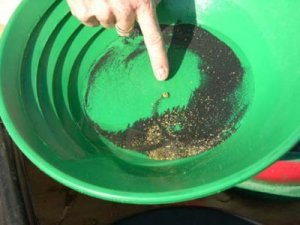 Otto captured the following video sequences as we were using the boat to move our dredges around:
Otto captured the following video sequences as we were using the boat to move our dredges around:
Craig’s crew wasted no time in setting up the 8-inch dredge on the far side of the river. Their first test hole was put down into high-grade gold not far off the stream bank. The streambed material over there was less than 3 feet on top of some rough bedrock. Those
guys came up hooping & hollering after the very first dive! I remember thinking, “Wow, this is going to be an easy week!”When I went over to take a look, they already had a good showing of gold in their pan for just the little work they had done! So I encouraged Craig’s team to drop the 8-inch dredge further downstream to see if they could pick up an extension of the high-grade.

Jason and his team set up the 6-inch dredge on the Klamathon Road-side of the river. Jason then went out into the river on an extended airline to do an underwater survey. This is a drill where we attach 2 airlines together so the person can get out as much as 90 or 100 feet into the river away from the dredge. While the dredge is operating at idle (to provide air to the diver), with his lead weights on, Jason crawled out to take a good look at the river-bottom in the area where we wanted to get a good sample. Normally when we do this, we are looking for places where the bedrock is exposed along the bottom of the river. This allows us to target sample locations where we know that streambed depth will not extend beyond our reach. While crabbing around out there on the bottom, Jason found a place where someone else had already dredged a sample hole to the bedrock in about 5 feet of hard-packed streambed material. He and his team were lucky. They would have an opportunity to get a sample out there without having to dredge an entire sample hole from scratch. This saved them about a full day of work!
 Like Craig’s crew on the other side of the river, Jason’s team was cheering their results by the end of our first day on the river. Except that Jason’s crew was finding nice gold nuggets! The following video sequence was captured as Jason’s team was just pulling the first nuggets from their sluice box:
Like Craig’s crew on the other side of the river, Jason’s team was cheering their results by the end of our first day on the river. Except that Jason’s crew was finding nice gold nuggets! The following video sequence was captured as Jason’s team was just pulling the first nuggets from their sluice box:
Andrew and I were not recovering very much gold on the 5-inch dredge over near the edge of the river; but by the end of the first day, all of our beginners had progressed to spending some time dredging underwater. This was a good beginning!
It took another day before all of our beginners had graduated to the 6-inch dredge. This required us to move a few of Jason’s guys over to the 8-inch dredge. Consequently, both dredges could be operated in shifts all day long. After that, we just used the 5-inch dredge to provide extra air for the divers.
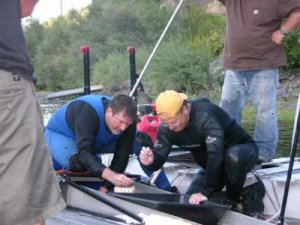 As often happens, the two dredging teams quickly evolved into some friendly competition. While it is nearly impossible for a 6-inch dredge to match the production (nearly double) of an 8-inch dredge, Jason’s team gave Craig’s team a good run for their money all week long. This was because the stronger line of beautiful nuggets was running down Jason’s side of the river. The following video sequence captured how much excitement was going around while we recovered all that beautiful gold:
As often happens, the two dredging teams quickly evolved into some friendly competition. While it is nearly impossible for a 6-inch dredge to match the production (nearly double) of an 8-inch dredge, Jason’s team gave Craig’s team a good run for their money all week long. This was because the stronger line of beautiful nuggets was running down Jason’s side of the river. The following video sequence captured how much excitement was going around while we recovered all that beautiful gold:
There was a little frustration during the first few days on Craig’s dredge, because the pay-streak was not as rich when they dropped back and dredged another sample hole. It is always hard to drop back on a high-grade pay-streak. We do it to block-out a whole section of high-grade material in front of us. This is kind of like having money in a bank account! Otherwise, you can dredge forward and drop tailings all over the best gold!
Since several of the participants in this Project were planning to stay around for another week or two after we finished (using their own dredges to work the pay-streak), it seemed worth the effort to drop back and provide them with some good high-grade to dredge when our week together was over. It took about 3 sample holes for Craig’s team to work it all out. After that was accomplished, they were hooping & hollering on Craig’s dredge for the rest of the week.
 Because the streambed material was deeper where Jason got started, we did not bother to drop the 6-inch dredge back on the pay-streak. That would have taken too much of our limited time. So there will be plenty more high-grade to go back to during the upcoming season. We will do another Project in there unless someone else beats us to it!!
Because the streambed material was deeper where Jason got started, we did not bother to drop the 6-inch dredge back on the pay-streak. That would have taken too much of our limited time. So there will be plenty more high-grade to go back to during the upcoming season. We will do another Project in there unless someone else beats us to it!!
This was kind of an unusual dredging Project, in that we were recovering nice gold from our first day of operating dredges on the river. More often, it takes us several days of progressive, coordinated sampling to walk our way into a rich pay-streak. Still, we had some interesting challenges to overcome in developing this gold deposit. The richest portion clearly was located in the middle of the river where the water-flow was stronger. There were some big rocks out there that we needed to roll back. All of this took a serious, coordinated effort. The following video sequences will give you the reality that these are serious mining projects where everyone on the team is usually tested:
With all of the beginners integrated into the two production teams, and the friendly competition between the two dredges to find the most and best gold each day, this group evolved into a tight-knit team by mid-week. Nearly everyone was camped in the Club camping area located just up the road from where we were dredging. Evenings found us enjoying meals together over at Otto’s camp. We set up chairs near his barbeque, so we could enjoy the beautiful sunsets. There was a lot of excited conversation about the gold we were recovering – and the additional gold which must also be in that section of K-3. Otto is one of the best BBQ cooks I have ever met! He is always there with a friendly smile and helpful hand. So shared some nice, relaxing evenings after working hard on the river each day.
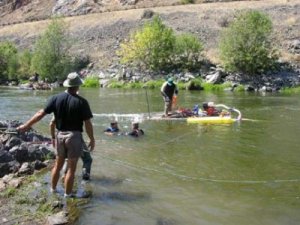 Our team was so grooved-in and organized by Thursday, that I found myself with nearly nothing to do. In fact, I was so bored, that I drank my whole thermos of coffee before noon, and had to go back to camp and brew up another pot! I am never comfortable just sitting around with nothing to do when there is productive activity going on all around me. Usually, on these Projects, there is an opportunity for me to take a short dive or two every day. I like to jump in and help with the sampling process. I like to jump in and operate the production dredge alongside a good support team that knows what to do. I get a big charge watching gold uncovered from a rich pay-streak!
Our team was so grooved-in and organized by Thursday, that I found myself with nearly nothing to do. In fact, I was so bored, that I drank my whole thermos of coffee before noon, and had to go back to camp and brew up another pot! I am never comfortable just sitting around with nothing to do when there is productive activity going on all around me. Usually, on these Projects, there is an opportunity for me to take a short dive or two every day. I like to jump in and help with the sampling process. I like to jump in and operate the production dredge alongside a good support team that knows what to do. I get a big charge watching gold uncovered from a rich pay-streak!
But I found myself a spectator up in the boat on Thursday afternoon. There was no place for me on the dredges. This team had taken completely over. They knew exactly what to do to prevent any momentum from being lost. They had it together so well, that I couldn’t even make any suggestions how to improve things. So I resigned myself to work on my sun tan up in the boat, while sitting back proudly watching my team. These partners were so good, that if we went another day, we would have had to split-off a third team onto the 5-inch dredge just to make the most out of them.
 Just to give them all a good run for their money, on Thursday afternoon, I challenged anyone to dive in on a breath of air, swim out to the middle of the river, and walk the 6-inch suction hose to the bank against the strong pull of the river. This is quite a challenging task. Not having done much that day, I was hoping to demonstrate for everybody how it is done. But Andrew succeeded on his first try.
Just to give them all a good run for their money, on Thursday afternoon, I challenged anyone to dive in on a breath of air, swim out to the middle of the river, and walk the 6-inch suction hose to the bank against the strong pull of the river. This is quite a challenging task. Not having done much that day, I was hoping to demonstrate for everybody how it is done. But Andrew succeeded on his first try.
At camp that night, we all agreed that we would use the final day to remove our gear from the river and do a final gold clean-up. As our project site was far from any road access points where we could back a trailer down to the river, we would normally break down the dredges and pack individual components up the hill. But this crew was so geared-up by now, that we packed the entire dredges up to the road without breaking them down! It only took us a few hours to remove all of our gear from the river.
We also helped several of the participants to move their personal dredges down the hill, so they could pick up in the pay-streak right from where we left off on the project. Other members were also moving in to take up positions not far up and downstream from where we were working. Smart moves! There was a lot of excitement going around!
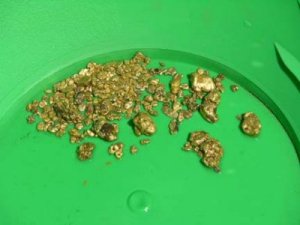

We accumulate our clean-ups all week inside of a 5-gallon bucket and save it all for the final day. It would subtract too much productive-time during the week if we were to perform a final clean-up every day. So we always allow the afternoon on Friday to do the final clean-up and split-off the gold evenly amongst all the participants. The following video sequences demonstrate that the final separation and gold-split are a fantastic way to end off on one of these projects. Receiving a split of the gold is a very satisfying acknowledgement for all of the hard work:
Friday afternoon found our entire crew doing the final clean-up process together up at camp. In all, we recovered 99.2 pennyweights (4.96 ounces) in beautiful gold, of which there were 27.9 pennyweights of nice nugget material. Each person received some of the nuggets. Everyone was happy with their individual shares. But I believe everyone was even more excited about the team experience and lasting friendships that we created on this project.

After doing a group photo, those of us that had to leave said our goodbyes and broke camp. The others stayed around to work the gold deposit. Other members were arriving just in time to take up our camping spots as we were pulling out.





